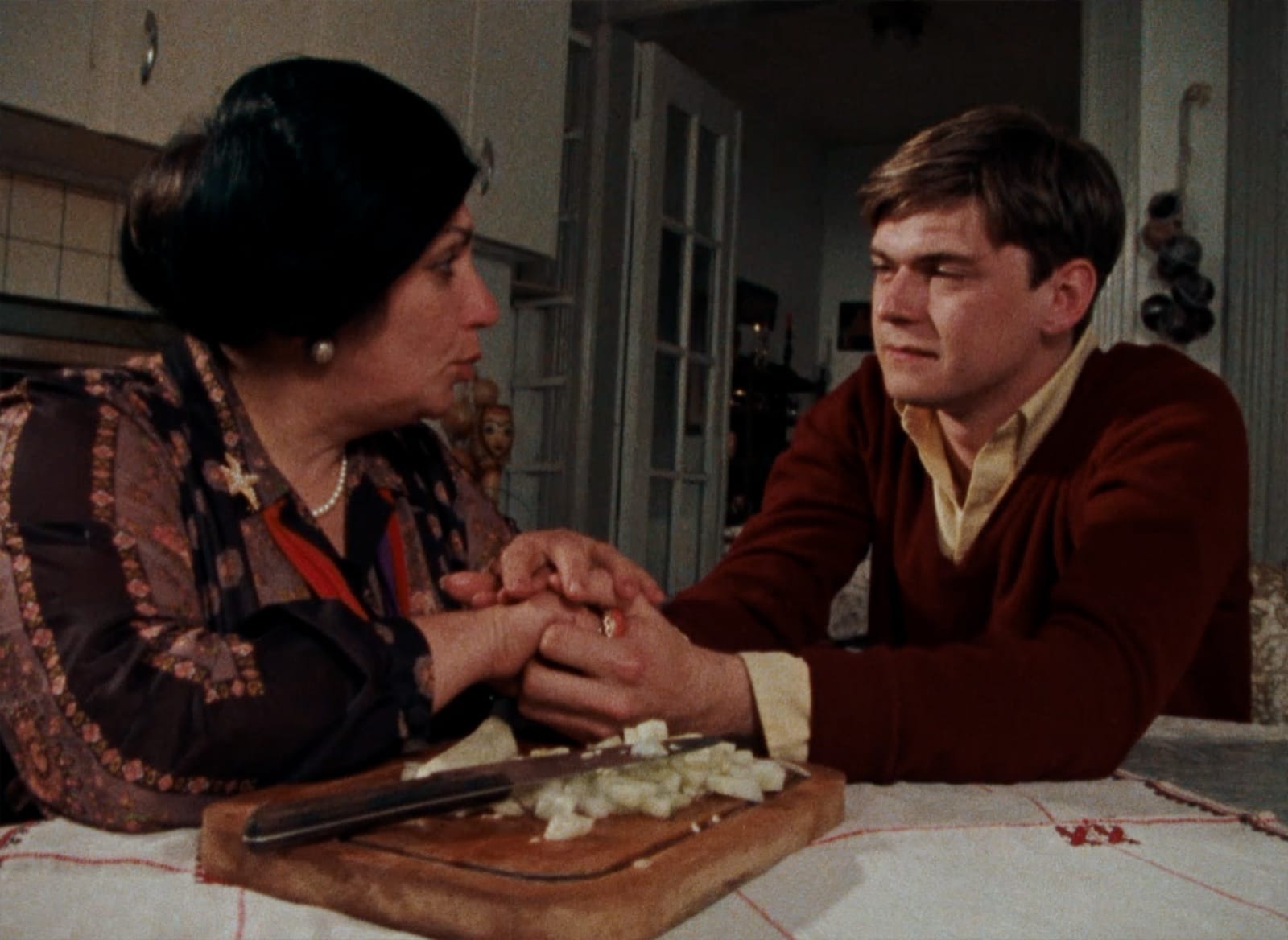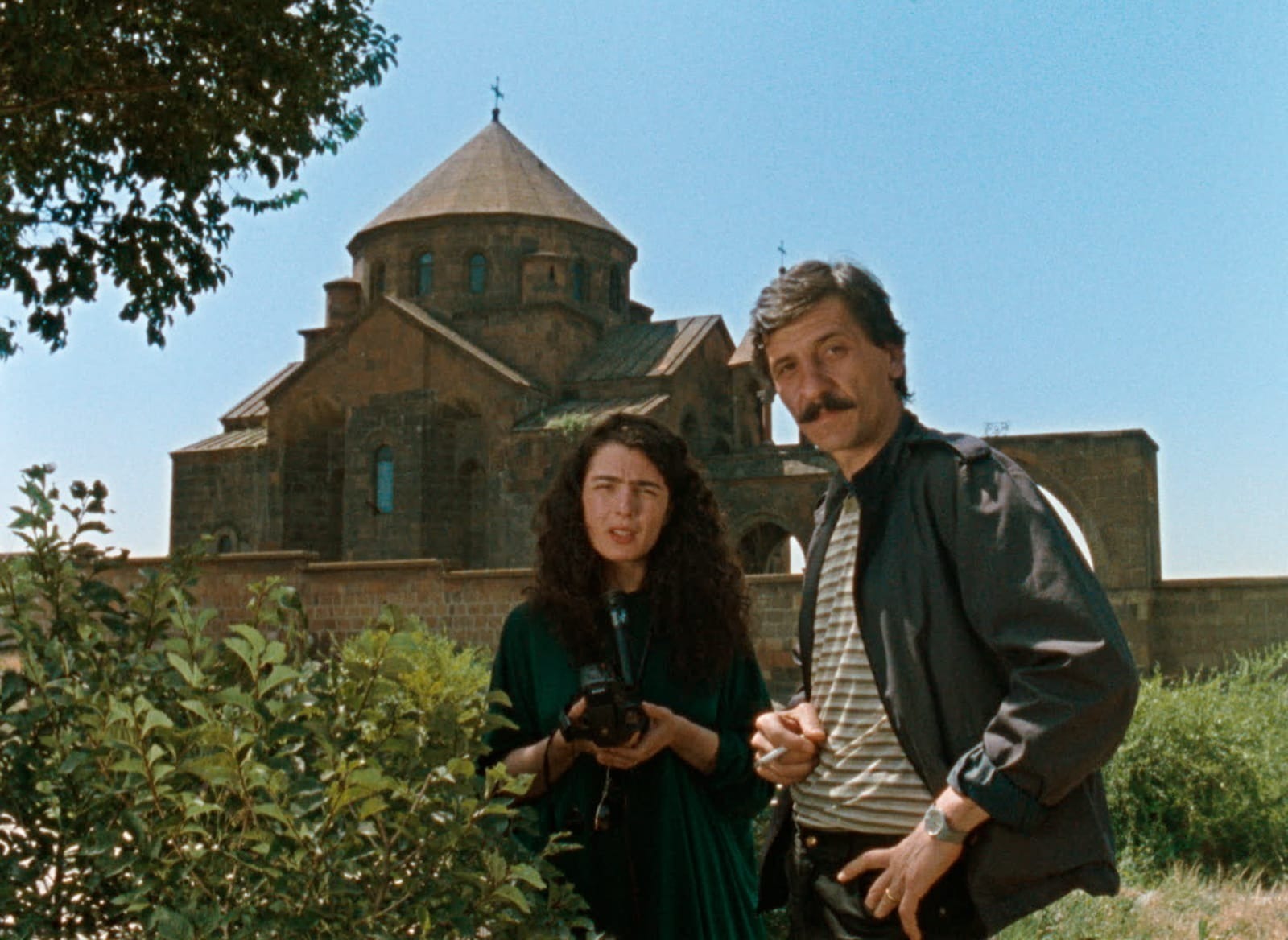RELATED ARTICLE
Carry That Weight: The Films of Atom Egoyan

Share
The first shot of Atom Egoyan’s 1984 debut feature, Next of Kin, is a ground-level pan across the baggage claim section at Toronto’s Pearson Airport. The camera is angled so that our gaze is on the various pieces of luggage rather than their owners—a mobile, Bressonian frame placed around a liminal, indistinct space. Seen this way, each bag becomes a locus of mystery and suspense. Perhaps unsurprisingly for a filmmaker whose childhood was defined by migration from Cairo to British Columbia, border crossing forms a modest but real motif in Egoyan’s work, with a special emphasis on the anxious intimacy of customs checks. In Ararat (2002), a young man working on a transnational film production is detained by an agent who intuits—correctly—that he’s smuggling drugs from Turkey into Canada; in Adoration (2008), the plot hinges on the discovery of a bomb hidden in an oblivious passenger’s carry-on. “You have to convince yourself this person has something hidden that you have to find,” explains an officer to his colleague early on in Exotica (1994),gazing intently through a one-way mirror at a man who may or may not have black market items secreted away beneath his sleek linen suit. “Check his bags, but it’s his face, his gestures that you’re really watching . . . look at him carefully . . . what do you see?”
Suspicion and investigation, cataloguing and speculation, concealment and revelation: Egoyan’s films give the impression of rifling through somebody else’s personal effects, of (re)constructing a subject’s life through an arcane yet intimate series of fragments. His is a cinema of unveiling, quite literally in Exotica’s humid strip-club milieu, where schoolgirls gyrate forlornly to Leonard Cohen with their eyes wide shut. He’s interested in characters who cleave their burdens to their chests or else stash them up their sleeves. Whether passive, obsessive, pathetically repressed, or just plain strange, these are people whose souls are weighted down. The films transfer some of that heavy lifting onto the audience; the characters’ catharses are synced to our gradual unraveling of the fanatically elaborate narratives. Egoyan’s plotlines, with their shuffled timelines and accordingly unwieldy relationship to cause-and-effect dramaturgy, inspire curiosity—that most thrilling and weightless of moviegoing sensations—while also requiring completion in the viewer’s consciousness. You can file his movies under “some assembly required.” For the majority of his career, Egoyan has been a filmmaker whose confidence in his abilities to make us pay attention belies his desire to test us, and by extension himself, on the limits of perception and engagement: to “look carefully” at his multilayered, coyly withholding, and often revelatory films is at once an invitation, a challenge, and a necessity.

The title of Next of Kin refers to the film’s less-than-submerged themes of generational distance. Peter (Patrick Tierney) is a disaffected twentysomething so luxuriously stifled in his metropolitan WASP-nest household that he attempts to convince a family of Armenian immigrants that he’s their long-lost son, an outrageous deception reflecting the ethnic and cultural identity crisis the then twenty-four-year-old Egoyan was experiencing as an Armenian-Egyptian living and working in a North American country. Peter’s preference for the boisterous intimacy of his “second” family seems to emanate directly from the filmmaker, albeit strategically transferred onto a white surrogate—a tricky bit of play with identification. In a larger sense, what Next of Kin signified was the emergence of an entire cohort of ambitious, distinctive young Toronto filmmakers who, whatever their individual influences or aesthetics, were pushing back against the tacky opportunism of Canada’s late-seventies, “tax shelter” era, during which generous government subsidies and a surfeit of “creative accounting” succeeded in transforming Canada’s largest city into “Hollywood North.” The irony was that an initiative designed to kickstart an English-Canadian film industry languishing in the shadow of the U.S. yielded mostly homegrown knock-offs of American genre product. The resistance of the so-called “Toronto New Wave” manifested in a series of movies more stylistically and philosophically indebted to international art cinema, movies that used their host city’s newly thrusting architectural modernism and burgeoning multiculturalism as a subject rather than a backdrop.
The seethingly cerebral thrillers of David Cronenberg led to the first stirrings of auteurist interest under the auspices of the Capital Cost Allowance, culminating in the commercial breakthroughs of The Brood (1979) and Scanners (1981). Next of Kin slotted more logically alongside other, more modest Torontonian curios like Ron Mann’s free-jazz odyssey Imagine the Sound (1981) and Peter Mettler’s impressionistic social portrait Scissere (1982). Even more than his experimentally minded peers, Egoyan’s work displayed a continuity with the angry-young-man thematics of previous local heroes like Don Owen and Don Shebib, whose Nobody Waved Goodbye (1964) and Goin’ Down the Road (1970) anticipated Next of Kin’s alienated protagonist, while also staking out its own ambivalently technophobic territory. Perhaps taking off from Cronenberg’s medium-is-the-message allegory Videodrome (1983), Egoyan’s next film, Family Viewing (1987), centers on Van (Aidan Tierney), a taciturn young man who’s mortified to discover that his father has taped over an entire collection of home movies with footage of his own perverse philandering. (Turnabout being fair play, Van is secretly sleeping with his dad’s mistress). Family Viewing’s combination of grainy, medium-cool visual textures with florid, deadpan psychodrama was novel, and while reviews were mixed in American precincts—“hopelessly arch” was the verdict of the New York Times—Egoyan quickly became the sly, owlish face of the Toronto New Wave, a symbol of a city’s cinematic progress and, more excitingly, its promise as well.
Fulfillment followed via Egoyan’s fourth feature, The Adjuster (1991), which premiered at the New York Film Festival and was invited to the Director’s Fortnight in Cannes on the strength of an impeccable formalism. A signature image: claims expert Noah (Elias Koteas) methodically and inexplicably shooting an arrow out of his bedroom window, muscles pulled taut across his bare back, an Apollonian figure aiming directly at an unseen target—a hint from director to spectator to look and think beyond the frame.








